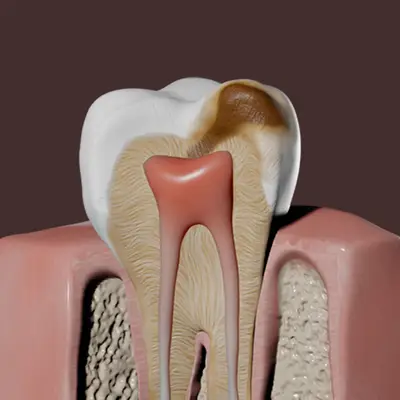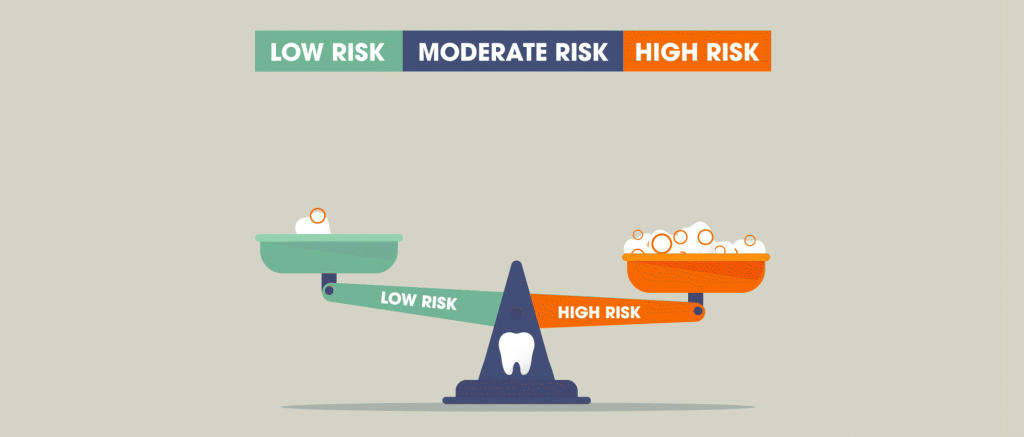
To lower cavity risk: improve daily brushing and flossing techniques, reduce sugar and simple carbs, use fluoride toothpaste and treatments, stay hydrated to maintain saliva flow, avoid acidic drinks between meals, and visit your dentist regularly for cleanings and assessments.

If you have any of the following signs or symptoms, please call to schedule a visit with your dentist right away. These are indications of a large cavity that requires treatment.
Many unique factors influence a person’s predisposition for cavities. We can explain these best by breaking them into a few broad categories. People with a high risk for developing new cavities typically have several risk factors combined.
Enamel Strength
Healthy tooth enamel is the hardest substance in the human body. It is stronger than bones and very difficult to penetrate. However, not everyone has strong enamel. For some people, enamel is naturally weak and thin due to genetic defects. Enamel can also weaken over time from damage, or natural erosion from everyday chewing.
It is important to understand that baby teeth have much thinner enamel than permanent teeth, so children can develop cavities more easily and more often than adults.
Saliva Quality and Quantity
Saliva is the body’s best natural defense against cavities. When you have naturally strong enamel and healthy saliva, your tendency to develop cavities is fairly low. This is important because enamel cannot grow back once damaged, but it can be made strong again. Saliva contains minerals to help re-harden the teeth, and it is alkaline in pH, which counteracts the acid attacks from cavity-causing bacteria.
When someone lacks healthy saliva and suffers from dry mouth, their cavity risk is automatically classified as high. That’s how important your saliva is!
Oral pH
An acidic pH inside the mouth increases the risk for cavities. This is because acid softens and weakens enamel, making it easier for bacteria to penetrate your teeth. A dry mouth results in an acidic mouth because it lacks the neutralizing effect of saliva. Health conditions like acid reflux, GERD, or frequent nausea and vomiting also create an acidic environment inside the mouth.
Understanding the pH of the beverages you drink is important, too. Constantly sipping sodas, coffees, or fruit juices throughout the day can lower the pH inside your mouth and increase your risk for cavities.
Oral Hygiene
Cavity-causing bacteria is what makes up dental plaque. The longer plaque stays on the teeth, the greater your likelihood for developing a dental disease. The purpose of dental hygiene is to remove plaque from the teeth so the bacteria within your mouth cannot cause cavities or gum disease.
When someone has poor technique or inconsistent oral hygiene, they end up leaving dental plaque on the teeth and trapped under the gums for days, weeks, or months at a time. This greatly increases the risk for cavities and gum disease.
Diet
Cavity-causing bacteria need carbohydrates to thrive. A diet high in sugar and other simple carbs feed these bacteria by producing acid that breaks down the tooth enamel surface, increasing the risk for cavities.
On the other hand, we can lower cavity risk by “starving” these bacteria by reducing sugars and other simple carbs from our diets. Choosing snacks that are mostly fats or proteins, like nuts and cheese, can help you fight cavities!
Prior Dental Work
The existence in someone’s mouth of a lot of dental work increases the risk for new cavities. Even wonderfully performed dental treatments carry a risk for future cavities. This is because the enamel is no longer intact. When there is an edge where the restoration (filling or dental crown) meets the tooth, dental plaque is attracted to that edge and will collect there if not properly cleaned.
The more existing dental work someone has, the higher their risk for cavities.
Dentists often use a tool called the CAMBRA, or Caries Management By Risk Assessment, to weigh the chance of caries development for a patient on a scale from disease to health. This helps explain your risk for cavities and how you can take steps to tip the scales to better your health.

While no one can have zero risk, those with a Low Risk simply need a maintenance routine to stay in the low risk range. This will include continuing good oral hygiene at home, seeing your dentist on a consistent basis, watching your diet and managing any dry mouth issues that arise.
Patients with a Moderate Risk for cavities need to take more action to lean more toward the healthy end of the scales. This should involve an improvement in both home care and the consistency of dental visits. We also recommend adding fluoride treatments and reducing sugar in your diet.
Those who have a High Risk for developing new cavities need to make changes that we call aggressively preventive. This means, to prevent developing further cavities, you should see your dentist more frequently than someone with a low risk, follow your dentist’s recommendations for preventive treatments, like professional fluoride applications, and reevaluate your habits. In order to lower a high cavity risk, you must greatly reduce your sugar intake, closely guard the pH of your mouth, and perform consistent and effective plaque removal every single day!

1. Enamel Strength – You can both strengthen your tooth enamel and protect it from weakening. To strengthen it, add fluoride or another remineralizing agent to your oral hygiene routine in the form of a toothpaste or mouthwash. Add in-office fluoride to your routine check-up each time you visit your dentist. Fluoride varnish applied during your dental visit sits on the teeth longer and allows more of the fluoride to be absorbed, which leads to great protection for a longer period of time. To protect your enamel strength, follow the steps under the Oral pH section below.
2. Saliva Quality and Quantity – It is important to stay well hydrated. Your body cannot make saliva when in a state of dehydration. You can stimulate additional saliva production between meals by eating sugar-free candy or chewing xylitol gum. The stronger the flavor, the more saliva you will stimulate!
3. Oral pH – In order to maintain a neutral pH in the mouth, there are several important points to consider. First, you must address dry mouth problems. Stimulating saliva will help, but if you have severe dry mouth, you may need to seek medical attention. You should also investigate the pH of the drinks you most commonly consume, as it is common for even some bottled or sparkling waters to be acidic. If they are acidic, reduce your intake, and try not to have them between meals when saliva production drops. Also, patients with medical conditions like acid reflux, GERD, or chronic vomiting should see their medical doctor for treatment. And drink plenty of plain water.
4. Oral Hygiene – As far as plaque removal goes, both consistency and technique matter. Plaque collects on the teeth all day every day, so you should never miss a day of brushing and flossing. Proper technique is equally important, as you could be missing areas of your teeth or gums without knowing. Ask your dental hygienist for a demonstration of the best brushing and flossing techniques for your mouth.
5. Diet – Since sugar feeds cavity-causing bacteria, you should cut out sugar as much as possible if you are at high risk for caries. Simple carbohydrates, like chips and crackers, have the same dangers as sweets. To lower the risk for cavities, alter your diet so that simple carbs and desserts are part of a meal instead of between-meal snacks, as the increased saliva produced during meals can help rinse your teeth of harmful bacteria. Consider switching to better snack choices like nuts or cheese for the times between meals.
6. Prior Dental Work – Restorative dental treatment is often necessary to rebuild the proper function and aesthetics of your mouth. After receiving treatment, your dentist will give you special instructions for how to maintain the restoration for as long as possible. With a proper oral hygiene routine you will improve your chances of preventing caries, and with regular dental exams you will be able to catch any concerns before they become overly problematic; potentially increasing the life of your restoration. While there are average lifespans of different dental treatments and restorations, it’s important to understand the impact you and your habits have on the longevity of your dental work.

The risk for cavities increases with age, so it is essential to develop good habits now. As we get older, our gums will naturally begin to recede, leaving us with more exposed tooth roots (without protective enamel covering them). Start caring for your teeth now so that you can maintain good oral health in the future.
Having a high risk for cavities does not mean developing new cavities is inevitable. You can take steps to reduce your risk and prevent cavities in the future. If you have any concerns about your own cavity imbalance, let us help you today!